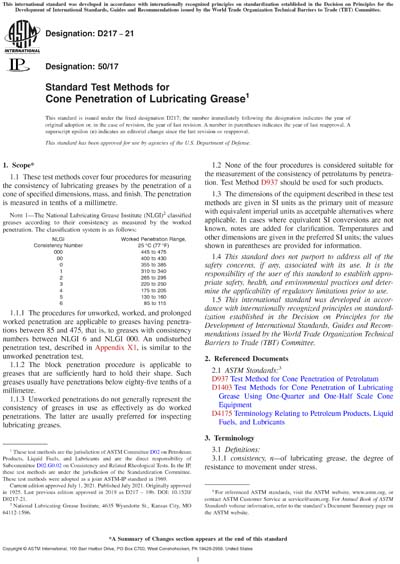Historical
ASTM D217-21
Standard Test Methods for Cone Penetration of Lubricating Grease
1.1These test methods cover four procedures for measuring the consistency of lubricating greases by the penetration of a cone of specified dimensions, mass, and finish. The penetration is measured in tenths of a millimetre.
Note 1:The National Lubricating Grease Institute (NLGI)2 classified greases according to their consistency as measured by the worked penetration. The classification system is as follows:
1.1.1The procedures for unworked, worked, and prolonged worked penetration are applicable to greases having penetrations between 85 and 475, that is, to greases with consistency numbers between NLGI 6 and NLGI 000. An undisturbed penetration test, described in Appendix X1, is similar to the unworked penetration test.
1.1.2The block penetration procedure is applicable to greases that are sufficiently hard to hold their shape. Such greases usually have penetrations below eighty-five tenths of a millimetre.
1.1.3Unworked penetrations do not generally represent the consistency of greases in use as effectively as do worked penetrations. The latter are usually preferred for inspecting lubricating greases.
1.2None of the four procedures is considered suitable for the measurement of the consistency of petrolatums by penetration. Test Method D937 should be used for such products.
1.3The dimensions of the equipment described in these test methods are given in SI units as the primary unit of measure with equivalent imperial units as accetpable alternatives where applicable. In cases where equivalent SI conversions are not known, notes are added for clarification. Temperatures and other dimensions are given in the preferred SI units; the values shown in parentheses are provided for information.
1.4This standard does not purport to address all of the safety concerns, if any, associated with its use. It is the responsibility of the user of this standard to establish appropriate safety, health, and environmental practices and determine the applicability of regulatory limitations prior to use.
1.5This international standard was developed in accordance with internationally recognized principles on standardization established in the Decision on Principles for the Development of International Standards, Guides and Recommendations issued by the World Trade Organization Technical Barriers to Trade (TBT) Committee.
Content Provider
ASTM International [astm]






